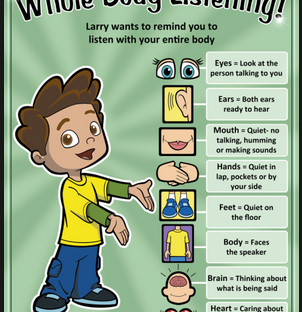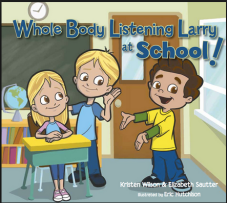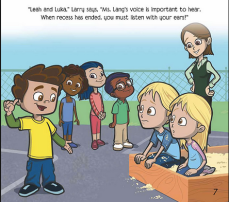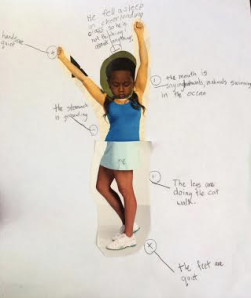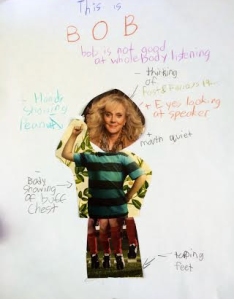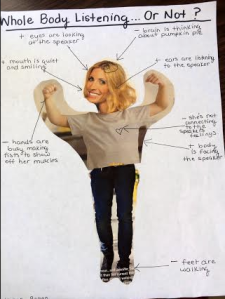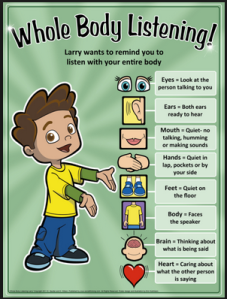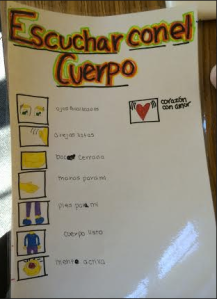Let’s play a game called concrete or abstract. I’ll say a word and you decide if it’s concrete (simple to picture, describe and define) or abstract (context-based, dynamic, challenging to consistently define). Here we go:
1. MOOSE: Concrete or Abstract?
2. SUCCESS: Concrete or Abstract?
3. FORK: Concrete or Abstract?
4. LISTENING: Concrete or Abstract?
Today’s post is all about number four: Listening. Despite being one of the most common words I hear in K-8 classrooms (and I have no doubt it’s a high frequency word in high school as well), LISTENING is an abstract concept. My image of listening may be very different than your image of listening. Listening on the playground may look different than listening during a math lesson. Some teachers want students to listen with their ears alone, while others expect students to freeze whatever they might be doing in order to listen. Neurotypical students struggle to form consistent rules for listening, so imagine how challenging this is for children with language processing challenges, lack contextual awareness, challenges recognizing social cues, and overly rigid interpretations of social situations. We need a hero!!!!!
WHOLE BODY LISTENING to the rescue! Whole Body Listening (WBL) is a term coined by Susanne Poulette Truesdale in 1990, and later adopted into the Social Thinking Curriculum (Michelle Garcia Winner). The goal of WBL is to transform an abstract concept (listening) into a concrete, highly comprehendible one. Rather than require children to determine what is meant by “Listen to me,” each part of the body is described as either active/on or quiet/off:
Active/On:
- Ears are hearing what is being said
- Eyes are looking at the speaker
- Brain is thinking about what is being said
- Heart is caring about how the speaker is feeling
- Body (upper body) is facing the speaker
Quiet/Off:
- Mouth is quiet
- Hands are quiet and not distracting self or others
- Feet are quiet and not distracting self or others
Reinforcing WBL requires a shift from “Listen to me,” “I need everyone listening,” and “I’ll wait until the whole class is listening” to “I’m waiting for quiet mouths and eyes looking at me,” “Let’s be whole body listeners; brains, ears, eyes, and hearts on and mouths, hands, and feet quiet,” and “I will know you’re listening with your whole body when your hands and feet are quiet.” Taking the guesswork out of listening allows children to more quickly and easily understand the whole-body expectations of being a strong listener, allowing them to engage more successfully in classroom tasks.
At The School of The Madeleine in Berkeley, CA, we are bringing WBL to every classroom, K-8. Here are some creative ways to teach WBL skills to students in all grades:
Kindergarten through 2nd Grade: Read the Whole Body Listening Larry Books to teach students the components of WBL with the help of Larry, a lovable illustrated character: Whole Body Listening Larry at School by Kristen Wilson and Elizabeth Sautter and Whole Body Listening Larry at Home by Kristen Wilson and Elizabeth Sautter. You can then play “Larry says,” a spin-off of “Simon Says.”
3rd through 5th Grade: Create crazy character collages and ask students to label whether the parts of WBL are being done in an expected way or an unexpected way.
6th through 8th Grade: Collaborate with students to translate the traditional WBL Larry poster (most appropriate for younger students) into a foreign language being taught across the school. Additionally, older students can be encouraged to reinforce WBL for younger students during assemblies, transitions, buddy activities, etc.
Whole School: Encourage “contagious quiet” across all grades in a school. Create a hand sign that represents WBL (like a ‘W’ with your fingers) and challenge students to see how quickly they can all “catch the quiet” when they see the hand sign.
A happy child is a child who feels successful, and WBL is a fantastic strategy to allow all students to feel like successful listeners!
